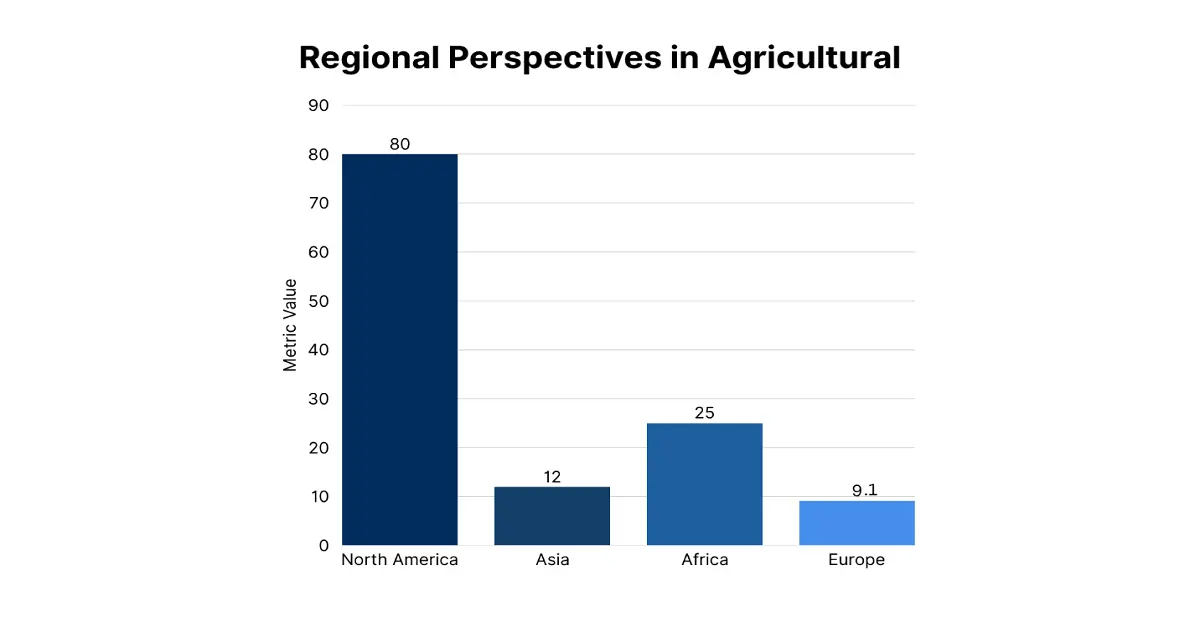Published Date : 27 October 2025
Posted by : Shweta Singh
The agriculture industry, one of the oldest human pursuits, is undergoing a significant transformation. Driven by advancements in technology, sustainability initiatives, and evolving global demands, modern agriculture is revising how we produce food, manage resources, and address environmental barriers. This blog studies the current state of the agriculture industry, its innovations, challenges, and future potential, supported by statistical and factual insights.
The Transformation in Agriculture
The agriculture sector has drastically changed over recent years. What began as a labor-intensive subsistence activity has turned into a sophisticated industry worldwide. With the global population expected to reach USD 9.8 billion by 2050, according to the United Nations, the pressure to produce more food using limited resources is increasing. To meet this demand, food production will need to increase by nearly 60%. At the same time, climate change, environmental degradation, and decreasing resources are encouraging the adoption of modern practices to ensure food security and sustainability.
Key Drivers of Change
- Population Growth: The Food and Agriculture Organization (FAO) projects that global agricultural output must rise by 70% to satisfy future food needs.
- Climate Change: Climate change is disrupting growing seasons. The Intergovernmental Panel on Climate Change (IPCC) estimates that every 1°C rise in global temperature can decrease crop yields by 3-5%.
- Limited Resources and Arable Land: According to the World Bank, just 12% of the Earth's surface is now suitable for agriculture, as arable land is shrinking. Thus, the land is under constant pressure from urban development and soil degradation.
- Evolving Consumer Preferences: The demand for organic and sustainably produced food is increasing, with the global organic food market accounting for USD 130.6 billion in 2022.
Technological Innovations Shaping the Agricultural Sector
The agriculture industry is well adopting next-generation technologies to increase productivity, reduce environmental impact, and optimize resources. Given below are a few of the transformative innovations:
1. Precision Agriculture: Precision agriculture uses data-driven tools like GPS, IoT, and drones to optimize farming practices. Farmers can overlook soil health, weather patterns, and crop conditions in real-time, improving efficiency and yields.
- Drones are used to measure land, monitor crop health, and utilize fertilizers with high precision.
- IoT Sensors help control soil moisture and nutrient levels, reducing water use by up to 30% (USDA).
- AI systems IBM’s Watson Agriculture analyzes large datasets to predict yields and early pest detection, helping in smarter planning.
2.Vertical Farming: Vertical farming, i.e., growing crops in stacked layers indoors, addresses land scarcity and urbanization problems. These mechanisms use 90% less water than traditional farming. Additionally, the vertical farming market is expected to expand at a robust pace, with top innovators like AeroFarms and Plenty leading this space, producing vegetables in urban settings with lower environmental concerns.
3. Biotech and Genetic Advancements: Genetic engineering, including CRISPR gene-editing, is helping develop crops that resist drought, pests, and disease. In 2022, 190.4 million hectares of GM crops were planted globally, led by soybeans and maize (ISAAA). CRISPR-edited crops, like drought-resistant wheat, are handling climate challenges. Biotechnology also reduces pesticide use by 37% for GM crops, according to a 2020 study in Nature.
4. Automation and Robotics: Robotic systems precisely manage labor-intensive tasks of harvesting, planting, and weeding. According to Research Nester, the agricultural robotics market is projected to grow to USD 20.6 billion by 2025. A few of the examples include:
- Autonomous Tractors: John Deere’s automatic tractors use AI to plow and plant crops with high precision.
- Harvesting Robots: Companies like Agrobot build robots to pick fruits, reducing labor expenses by 25-40%.
5. Blockchain for Supply Chain Transparency: Blockchain assures traceability in food supply chains, addressing consumer demand for transparency. In 2023, 68% of consumers prioritized knowing the origin of their food. Walmart uses blockchain to monitor produce, lowering recall times from days to seconds.
Sustainability: The Key to Modern Agriculture
Sustainability is no longer optional; it is a necessity. Agriculture contributes 14% of global greenhouse gas emissions (IPCC), prompting a shift toward eco-friendly practices.
- Regenerative Agriculture: Regenerative farming focuses on soil health, carbon sequestration, and biodiversity. Practices of cover cropping and no-till farming enhance soil fertility and reduce erosion. 2021 research by the Rodale Institute discovered that regenerative systems can capture and store 1 to 2 metric tons of carbon per hectare each year.
- Water Conservation: With the agriculture sector using almost 70% of global freshwater, according to the World Bank, efficient water use is very necessary. Agriculture uses drip irrigation systems to deliver water directly to plant roots, reducing water waste by 50% as compared to traditional methods. Moreover, Israel, a leader in water-efficient agriculture, recycles 90% of its wastewater for agricultural use.
- Renewable Energy Integration: More farms are opting for wind and solar to power equipment and irrigation, lowering reliance on fossil fuels. In addition, solar-powered irrigation systems are revolutionizing agriculture in water-scarce regions such as Sub-Saharan Africa.
Agriculture Across Regions: Global Analysis
North America: The U.S. dominates the biotechnology and automation sector. Genetically modified crops contribute to around 80% of all corn and soybean cultivation, as per the U.S. Department of Agriculture (USDA).
Asia: Asia, holding about 60% of the world’s population, faces rising pressure to increase food production. Countries like China are investing in innovation to fulfill the rising demand. Additionally, investments in agriculture, including AI and IoT, are predicted to reach USD 13 billion by 2026.
Africa: The agricultural future in Africa looks promising. With a large batch of the population being young and vast areas of fertile cultivable land available, it has robust growth potential. According to the International Fund for Agricultural Development (IFAD), platforms like FarmCrowdy are helping farmers connect directly with buyers, leading to increased income of 20% to 30% in some cases.
Europe: Europe emphasizes mostly on sustainability, with organic farming covering 9.1% of agricultural land in 2021. The European Union is pushing forward with its Green Deal, an ambitious plan aimed at making farming across the continent climate-neutral by 2050 through reduced emissions, eco-friendly practices, and greater use of renewable resources.

The Future of Agriculture
Agriculture today is facing a defining moment. The industry must find ways to embrace new technologies while remaining deeply committed to the health of the environment. With the global population climbing and climate patterns becoming more unpredictable, the farming sector is under pressure to evolve. Looking ahead, several transformative trends are set to restructure the future of farming, ushering in a new era of precision, resilience, and ecological harmony.
1. Lab-Grown Food: One of the most exciting developments, a new frontier in agriculture is lab-grown or cultivated food. Instead of raising animals, scientists can now grow meat, dairy, and seafood products from animal cells in highly controlled environments.
- Reducing Emissions: According to the Good Food Institute, cultivated meat could minimize greenhouse gas emissions from livestock by up to 80%, while also drastically lowering land and water use.
- Ethical Benefits: This method also solves many of the concerns around animal welfare in traditional farming systems.
- Market Growth: The global cultivated meat market is gaining popularity, with governments such as Singapore and the U.S. already approving products for commercial sale. Apart from meat, researchers are also building lab-grown dairy protein, eggs, and even coffee, reflecting a broader move to sustainable alternatives in the food supply chain.
2. Climate-Resilient Crops Through Genetic Innovation: Unstable weather, droughts, and crop diseases are already disrupting farming across the globe. To adapt, researchers are choosing gene-editing technologies to breed crops that can grow under difficult conditions.
- Drought Resistance: New varieties are being developed to conserve water and survive longer dry periods.
- Natural Protection: Genetically strengthened plants can resist pests and diseases, reducing the need for chemical treatments.
- Faster Adaptation: Gene-editing allows scientists to respond more quickly to new agricultural challenges, from new plant diseases to changing environmental conditions.
3. Smart Farming: Technology is gradually becoming as essential to farming as tractors and irrigation. Modern farms are increasingly depending on data to make faster, better decisions.
- Predictive Analytics: By understanding historical weather data, soil health, and crop performance, farmers can plan plantations with better accuracy.
- Real-Time Insights: Sensors placed in fields can track everything from soil moisture, nutrient deficiencies, and pest activity on a minute-by-minute basis, helping farmers to act before small issues become big problems.
- Automation at Work: Robotic machines and self-driving tractors are already decreasing the need for manual labor and improving efficiency on large farms.
Industry reports, such as one by Research Nester, estimate that by 2030, around 75% of large farms will be using some form of smart technology. These systems not only improve yields but also help to cut waste and environmental impact.
What lies ahead for agriculture is not a choice between high-tech solutions and sustainable practices; it is the amalgamation of both. By adopting innovations such as lab-grown food, drought-resistant crops, and smart farming mechanisms, the industry is set to confront the complex challenges of this century. The target is not only to produce more food, but to do so in a way that is kinder to the Earth, fairer for farmers, and healthier for all. The future of farming is not just about feeding the world; it is about feeding it wisely. As long as farmers, policymakers, investors, and consumers continue working together, agriculture is well-positioned to meet future challenges head-on.
Contact Us







